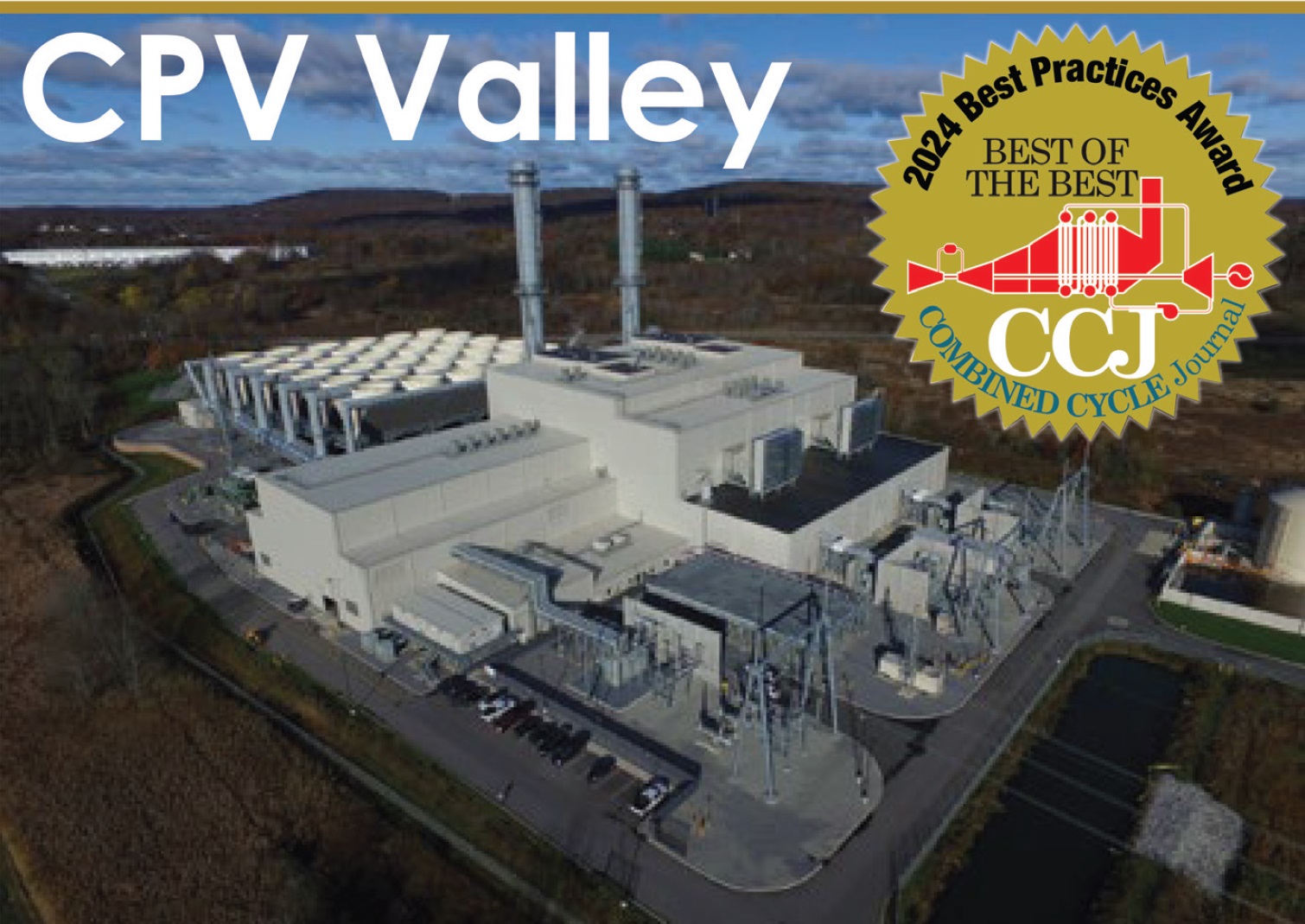
2024 501F BEST PRACTICES AWARDS: BEST OF THE BEST
- Anti-icing system prevents snow-related derates, outages
- The road to reliable ultrafiltration
- Experience upgrading Siemens’ T3000 V9.2
CPV Valley Energy Center
Owned by CPV/Diamond Generating Corp
Managed by Competitive Power Ventures
Operated by DGC Operations LLC
680 MW, gas-fired 2 × 1 SGT6-5000-powered combined cycle, located in Middletown, NY
Plant manager: Michael Baier
Challenge. Using supported, patched, and up-to-date software is a good cybersecurity practice. Using obsolete versions of software means that the patches and updates to the software will no longer be developed, and supported, which puts users at an increased risk of cyber threats such as ransomware. CPV Valley had an early version of Omnivise T3000 DCS and was approaching the extended end date for the Windows servers. Once the extended end date passed, there would be minimal support that could be provided for the DCS, ultimately decreasing the effectiveness against cyberattacks.
Solution. To ensure that the CPV Valley Energy Center could operate in the future using a DCS that was fully supported with patching available, DGC Operations, CPV, and Siemens Energy worked collaboratively to upgrade the DCS to the latest version of T3000. The plan initially was to upgrade to T3000 V8.2; however, with the T3000 V9.2 finishing up development for US implementation, the decision was made to upgrade to V9.2 to provide for a longer window before obsolescence.
To be sure there was an adequate outage opportunity to complete the upgrade implementation with work scheduled during concurrent hot-gas-path (HGP) inspections on both gas turbines in fall 2023. Monthly meetings were started in summer 2022 to discuss the implementation schedule, status of the project, hardware lead times, support/recommended actions that should be completed by the plant before the work began and any other items related to the project. DCS consultant Selva LLC, was brought in (spring 2023) as a third party to support the upgrade.
Several tasks completed prior to the upgrade proved beneficial. Specifically, a backup was taken of all the logic in a JAR file and screenshots of all the plant displays were captured and organized. The process of capturing screen shots and organizing them started about a month prior to the upgrade and involved plant operators, plant management, and Selva.
Plant operators took additional screenshots of plant displays that contained equipment or processes with manual set points. This was advised because when the new DCS version was installed, the manual set points would not be carried through from the old version.
Other tasks completed prior to upgrade were a review of new cabinet drawings, inventory of items shipped to site, and attendance at the factory acceptance testing (FAT) to witness the performance of new software and hardware capabilities. CPV Valley sent the plant engineer, an IC&E technician, and a lead shift operator, and Selva, to the FAT at Siemens Energy’s facility in Georgia. Server fail-over tests were performed, as well as UPS and scalance communication tests. Plus, the functionality of Version 9.2 was confirmed.
After the FAT was completed, all the hardware was packaged up and sent to the site. The upgrade took place during concurrent HGP inspections of both GTs. Since the upgrade process would render the DCS unusable for a couple of days, the upgrade was scheduled for the second week of the outage when all turbines would be off turning gear. Upon arriving onsite, Siemens Energy personnel worked with Selva to record all equipment timer information and take one last backup prior to upgrading the T3K.
Once the upgrade team received permission to proceed, the old hardware was decommissioned and the team went about installing/wiring up the updated hardware—including servers, communication modules, thin clients, scalances, and GPS antennas. After installation, Siemens Energy worked with the consultant to install licensing and perform loop checks of the new equipment. Upon completion of the system tests and manual set points being reset, consultant and Siemens Energy personnel departed the site—save one engineer. That person remained onsite until after the plant started up from the HGP outage. Several months after completion of the upgrade, the site coordinated with Siemens Energy to have a T3000 expert to come to the site for two weeks to train all O&M personnel on V9.2.
Results. The upgrade was completed successfully and on schedule because of the advance planning by all parties involved. One of the main reasons for project success was efficient communication throughout the entire planning process. While the site had the same lead on the project from start to completion, there were several project-manager changes on the DCS upgrade team.
Detailed meeting minutes and notes with action items ensured there was continuity among project managers and no time was lost as a result. Siemens Energy worked with the site team to develop a clear division of responsibility for all parties involved, accounting for all tasks and allowing for accountability and tracking throughout the project.
The screen shots taken of the plant display and the recording of the manual set points proved invaluable while getting the plant ready for startup. Even though most of the set points were re-entered by the consultant there were a couple instances where an operator noticed a set point was incorrect or questioned it. Having the backup, the correct set point was entered or confirmed to be correct within minutes of the discovery, minimizing any potential delay in the startup.
Hiring a third-party consultant was a big contributor to project success. Selva was very familiar with the site’s DCS and had years of experience working with the T3000; plus, it had expertise in powerplant operations. Having that resource available, provided the site with outside guidance during the planning process and an oversight during the implementation process.
With all the other jobs included during an HGP that require facility management oversight, having a liaison between the engineers completing the upgrade, and management, kept work moving at the pace required to meet schedule. The consultant also attended every meeting possible and assisted in the pulling of backups and making sure the site had all the documentation needed to complete the upgrade.
Other critical functions of the consultant were to archive operating parameters—like tuning constants, operator set points, timer settings, and ensure the ability to migrate to the new controllers after power-up. This effort assured a smooth migration.
Another beneficial decision was to send site personnel to the FAT. In order to extract the most value out of the trip, CPV Valley sent personnel from three separate departments—each assigned with different tasks and responsibilities. This allowed for a thorough check of all the logic loaded onto the new servers to ensure plant displays were the same as the previous version. Running through the testing of the hardware also provided some staff with a level of familiarity with the system before it was even installed.
The FAT also allowed plant staff to meet the people performing the upgrade and talk in more detail about the scheduling and sequence of the upgrade tasks. Note that during the FAT, CPV Valley and Siemens Energy coordinated to allow a third party design an anti-icing system for the site to mobilize an engineer to test the new logic in V9.2.
Finally, keeping one engineer onsite after implementation of the upgrade was invaluable in terms of facilitating a timely startup. As expected with a control-system upgrade, there were a couple of faults with the processors and some networking alarms that came in. Having the Siemens Energy engineer onsite to immediately support the upgrade reduced the amount of time it took to resolve any issues without involving the OEM’s remote engineering support group.
For CPV Valley’s upgrade there was an instance where a physical wiring change had to be performed on one of the automation processors. Completion of the change only took minutes with personnel on hand who knew exactly where to land the wire and could make redlines to the cabinet drawing to send back to the T3000 V9.2 upgrade project manager.
Project participants:
Michael Baier, plant manager
McKenzie Slauenwhite, plant engineer
Thomas Viertel, maintenance manager
Dave Engleman, operations manager
Bob Arraiz, lead IC&E technician
Daniel DeVito, IC&E technician





